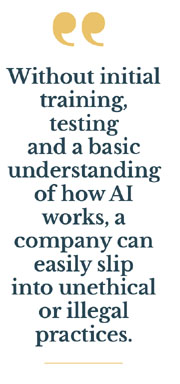It is no secret that AI is now seen as an engine of innovation. Software solutions capable of automating tasks, analyzing huge volumes of data, and supporting human decision-making are appearing in various sectors. Whoever has the “intelligence” of machines on their side often gains a competitive advantage. Yet, alongside the enthusiasm for rapid development also comes responsibility for the consequences such technology brings - and that involves not only IT experts but also lawyers, compliance managers, DPOs, HR specialists, and other professions.
This is precisely where AI Governance comes in. What does it mean in practice? Above all, that a company does not leave the development or deployment of AI to chance or the individual initiatives of separate departments but implements a management system covering all phases of AI usage. From selecting and validating data, through ongoing testing for accuracy and fairness of models, to evaluating their impact on people. The goal is for the organization to understand the “pedigree” of each AI application: what data it originated from, what risks were identified, and how and when it will be monitored.
An important part of this is AI Literacy. Imagine marketers using a tool that predicts customer behavior without having any idea how the algorithm processes various categories of people or whether biases could emerge unnoticed. Or an HR department handing AI the task of selecting job applicants for interviews without knowing which specific attributes the software is evaluating. Without initial training, testing and a basic understanding of how AI works, a company can easily slip into unethical or illegal practices. AI Literacy ensures employees working with AI understand its principles, limitations, and can recognize when to switch on “human oversight” or call in the compliance department.
Why is this also a competitive advantage? Firstly, transparency and emphasis on ethics increase trust among customers and business partners. In an era of heightened sensitivity around privacy and fair data handling, a company’s reputation depends on its ability to openly explain how its AI works and why it is safe. Companies that prioritize a responsible approach usually perform better in tenders, gain regulatory approvals more quickly and are more attractive to investors. Moreover, in a public debate over the benefits and risks of AI, these organizations can present facts and argue clearly, proving their reliability even in crisis situations.
Secondly, AI Governance facilitates “guilt-free” innovation. While it might sound paradoxical, precisely these established processes and control mechanisms allow for faster experimentation. If you already have a clear agreement on how new algorithms are tested, who approves them, and what requirements they must meet, you do not have to handle each project “on the fly.” Without AI Governance, there is a risk that different departments will innovate without coordination, creating parallel models; and if something goes wrong, it will be difficult to determine who is responsible. These approaches also simplify scaling up to international markets, each with potentially different consumer protection, data protection, and other AI-related regulations. A company with a well-designed system can simply adjust the model’s parameters for a new country or segment, confident that internal processes include documentation, complaint handling procedures, and staff trained in AI Literacy.
These approaches also simplify scaling up to international markets, each with potentially different consumer protection, data protection, and other AI-related regulations. A company with a well-designed system can simply adjust the model’s parameters for a new country or segment, confident that internal processes include documentation, complaint handling procedures, and staff trained in AI Literacy.
Another effect is that AI Governance fosters significant cross-functional collaboration within organizations. Many managers realize that the success of AI projects cannot rely solely on the IT department but requires input from compliance, marketing, HR, security specialists and sometimes also external consultants, who can assess whether the chosen approach is genuinely sustainable. This creates space for more profound knowledge sharing and innovation that reflects diverse perspectives across the company.
Last but not least, the quality of AI Governance is becoming a measure of how prepared companies are for regulatory changes. The European AI Act, which highlights the principle of AI Literacy, is just one of many steps toward stricter oversight of algorithms. The earlier a company adapts and diligently applies established rules, the fewer costs it will face later when additional directives emerge or when regulators start conducting spot checks on how AI is used in practice.
Here, Einstein’s notion of “explaining simply” and Garner’s idea of “clear language” find real practical application: AI Governance should not be a set of lengthy, complicated bureaucratic documents but rather a practical and understandable tool that people in the company refer to whenever they are unsure how a new AI solution fits into ethical and legal frameworks. All that is needed is for the core documents and training to be designed so that even staff who are not managers or IT experts can grasp what is expected of them and how they can contribute to innovation without risking harm.
In summary, systematic AI management (AI Governance) and adequate AI Literacy are not just matters for lawyers or IT professionals. They represent a strategic stance that ensures a company does not treat AI as a chaotic experiment but rather as a tool that can accelerate and enhance its operations, while respecting the law, its customers, and its own people. In the long run, an organization that masters AI responsibly in a fast-moving world can build a stable and trustworthy position. And that is a genuine competitive advantage.
Pavol Szabo, Senior Managing Associate/Attorney, Deloitte Legal



Follow us